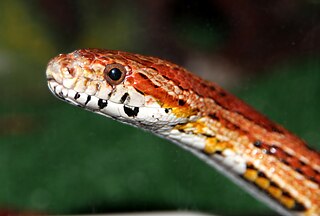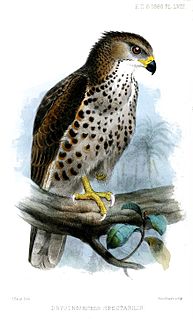
Eagle is the common name for many large birds of prey of the family Accipitridae. Eagles belong to several groups of genera, some of which are closely related. Most of the 60 species of eagle are from Eurasia and Africa. Outside this area, just 14 species can be found—2 in North America, 9 in Central and South America, and 3 in Australia.

Mixcoatl, or Camaztle[kaˈmaʃt͡ɬe] from camaz "deer sandal" and atle "without", or Camaxtli, was the god of the hunt and identified with the Milky Way, the stars, and the heavens in several Mesoamerican cultures. He was the patron deity of the Otomi, the Chichimecs, and several groups that claimed descent from the Chichimecs. While Mixcoatl was part of the Aztec pantheon, his role was less important than Huitzilopochtli, who was their central deity. Under the name of Camaxtli, Mixcoatl was worshipped as the central deity of Huejotzingo and Tlaxcala.

Boa is a genus of non-venomous boas found in Mexico, Central and South America. Four species are currently recognized. Common names include: boa and boa constrictor.

The crested serpent eagle is a medium-sized bird of prey that is found in forested habitats across tropical Asia. Within its widespread range across the Indian Subcontinent, Southeast Asia and East Asia, there are considerable variations and some authorities prefer to treat several of its subspecies as completely separate species. In the past, several species including the Philippine serpent eagle, Andaman serpent eagle and South Nicobar serpent eagle were treated as subspecies of the Crested serpent eagle. All members within the species complex have a large looking head with long feathers on the back of the head giving them a maned and crested appearance. The face is bare and yellow joining up with the ceres while the powerful feet are unfeathered and heavily scaled. They fly over the forest canopy on broad wings and tail have wide white and black bars. They call often with a loud, piercing and familiar three or two-note call. They often feed on snakes, giving them their name and are placed along with the Circaetus snake-eagles in the subfamily Circaetinae.

Acanthophis is a genus of elapid snakes. Commonly called death adders, they are native to Australia, New Guinea and nearby islands, and are among the most venomous snakes in the world. The name of the genus derives from the Ancient Greek akanthos/ἄκανθος ('spine') and ophis/ὄφις ('snake'), referring to the spine on the death adder's tail.

Oarfish are large, greatly elongated, pelagic lampriform fish belonging to the small family Regalecidae. Found in all temperate to tropical oceans yet rarely seen, the oarfish family contains three species in two genera. One of these, the giant oarfish, is the longest bony fish alive, growing up to 8 m (26 ft) in length.

Kukulkan, also spelled K’uk’ulkan, is the name of a Mesoamerican serpent deity. Prior to the Spanish Conquest of the Yucatán, Kukulkan was worshipped by the Yucatec Maya people of the Yucatán Peninsula, in what is now Mexico. The depiction of the Feathered Serpent is present in other cultures of Mesoamerica. Kukulkan is closely related to the deity Qʼuqʼumatz of the Kʼicheʼ people and to Quetzalcoatl of Aztec mythology. Little is known of the mythology of this Pre-Columbian era deity.

Pantherophis is a genus of nonvenomous colubrid snakes endemic to central and eastern regions of North America. They consist of the North American ratsnakes, the foxsnakes, and the cornsnakes. The genus first appeared in the fossil record in the Middle Miocene around 16.3 million years ago. In total there are 10 species recognized to be valid. They are a large terrestrial snake genus that lack subocular scales. Originally classified in the genus Elaphe, phylogenetic studies have found this taxon to be closely related to Pituophis. As with all snakes Pantherophis is an obligate faunivore with a diet that consists of small mammals, birds, reptiles and amphibians, and even insects. While many species conservation status is categorized as "least concern", many local populations in some species have declined where some places have them listed as federally protected. The corn snake is a popular pet reptile, due to the availability of captive-bred animals, their low maintenance and calm deposition, and the variety of color morphs. There are other species of Pantherophis that are in the pet trade, though are not as popular as the corn snake.

The giant oarfish is a species of oarfish of the family Regalecidae. It is an oceanodromous species with a worldwide distribution, excluding polar regions. Other common names include Pacific oarfish, king of herrings, ribbonfish, and streamer fish.

The Oenpelli python, known in binomial nomenclature as Nyctophylopython oenpelliensis, or Morelia oenpelliensis, is a species of large snake in the family Pythonidae. The species is endemic to the sandstone massif area of the western Arnhem Land region in the Northern Territory of Australia. There are no subspecies that are recognised as being valid. It has been called the rarest python in the world. Two notable characteristics of the species are the unusually large size of its eggs and its ability to change colour.

The Congo serpent eagle is a species of bird of prey in the family Accipitridae, and is sometimes placed in the monotypic genus Dryotriorchis by some taxonomic authorities. This species is distributed across the African tropical rainforest, including upper and lower Guinean forests. This serpent eagle specializes in hunting in these forests’ dark understories. It has two subspecies, the nominate subspecies Dryotriorchis spectabilis spectabilis and Dryotriorchis spectabilis batesi. Though monotypic, it appears to be very closely related to Circaetus. This hawk is a medium-sized bird with distinctive short, rounded wings and a long, rounded tail. It is varying shades of brown on its back and has a slight crest. Its breast is white with variable amounts of a rufous wash and, in the nominate subspecies, is covered in round, blackish spots. The subspecies D. s. batesi only has these dots on its flanks. The Congo serpent eagle closely resembles Cassin's hawk-eagle, and some ornithologists believe that this likeness is a rare example of avian mimicry. It is a very vocal raptor, and often is one of the most heard species in its habitat.

The Alethinophidia are an infraorder of snakes that includes all snakes other than blind snakes and thread snakes. Snakes have long been grouped into families within Alethinophidia based on their morphology, especially that of their teeth. More modern phylogenetic hypotheses using genetic data support the recognition of 19 extant families, although the taxonomy of alethinophidian snakes has long been debated, and ultimately the decision whether to assign a particular clade to a particular Linnaean rank is arbitrary.
Mixcoatlus barbouri is a venomous pit viper species endemic to Mexico. No subspecies are currently recognized.
Djoko Tjahjono Iskandar is an Indonesian herpetologist who studies the amphibians of Southeast Asia and Australasia. He is a professor of biosystematics and ecology at Bandung Institute of Technology in West Java, Indonesia.

Quetzalcoatl is a deity in Aztec culture and literature whose name comes from the Nahuatl language and means "Precious serpent" or "Quetzal-feathered Serpent". In the 17th century, Ixtlilxóchitl, a descendant of Aztec royalty and historian of the Nahua people, wrote, "Quetzalcoatl, in its literal sense, means 'serpent of precious feathers', but in the allegorical sense, 'wisest of men'."

Dipsadinae is a large subfamily of colubroid snakes, sometimes referred to as a family (Dipsadidae). They are found in most of the Americas, including the West Indies, and are most diverse in South America. There are more than 700 species.
Mixcoatlus browni is a species of pit viper found at high elevations in Guerrero, Mexico. This species was previously placed in the genus Agkistrodon, where it was considered to be a junior synonym of Cerrophidion barbouri. Molecular evidence has since demonstrated that M. browni is a distinct species and the genus name was subsequently changed.

Sibynophiinae is a small subfamily of colubroid snakes, sometimes referred to as a family (Sibynophiidae). This group has also been called Scaphiodontophiinae but since the name Sibynophiinae is older, it has priority. They are commonly called hinged-teeth snakes.
The pygmy mulga snake, also commonly known as the pygmy king brown snake, is a species of venomous snake in the black snake genus Pseudechis in the family Elapidae. The species is native to Australia.

The Colubroides are a clade in the suborder Serpentes (snakes). It contains over 85% of all the extant species of snakes. The largest family is Colubridae, but it also includes at least six other families, at least four of which were once classified as "Colubridae" before molecular phylogenetics helped us understand their relationships. It has been found to be monophyletic.
















